|
Did Aliens
Visit Our Ancestors?
By Steve Johnson
In 1968, Swiss author Erich Von Danikenís book,
Chariots of the Gods? stunned the literary world by becoming a
worldwide bestseller. Von Daniken suggested that extra-terrestrials had
visited Earth and took on the mantle of gods by our awe-struck ancestors.
His evidence came in the form of archaic writings, Biblical passages and,
most imaginatively, ancient works of art, such as sculptures, rock art and
jewellery, and enigmatic buildings and structures from ages past.
He was not the first to suggest that aliens had
interfered with our history and he definitely was not the last, authors
such as Zecharia Sitchin (The Twelfth Planet) and Alan Alford (Gods
of the New Millennium) continued these themes with varying success,
but he was absolutely the most successful.
Although derided by sceptics, the Ancient Astronaut
Theory (AAT) has a healthy following around the world, particularly
amongst internet groups and thousands of websites offer articles and
images as evidence that our planet has been visited by alien beings across
the millennia.
But is there any truth in the theory? Can we prove that
aliens did indeed come to Earth and, possibly, caused our earliest
civilisations to come into being? This article asks more questions than it
can answer!
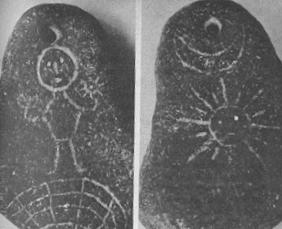 The
Stone Age amulet on the left was found in Ecuador. If it is genuine, it
suggests that ancient man knew that our planet was a sphere, long before
Europeans made that discovery for themselves. Did the person who sculpted
this simple piece of jewellery know for him or herself that the Earth was
round, or was this information passed on from extra-terrestrials? The
Stone Age amulet on the left was found in Ecuador. If it is genuine, it
suggests that ancient man knew that our planet was a sphere, long before
Europeans made that discovery for themselves. Did the person who sculpted
this simple piece of jewellery know for him or herself that the Earth was
round, or was this information passed on from extra-terrestrials?
Why would aliens inform a primitive human about the
Earth's place in the cosmos and explain how the Earth may be measured
using lines of longitude and latitude?
Or is it merely an abstract, religious or decorative
device, with no reference to what only seems to be depicted on its
face?
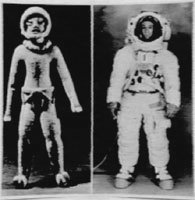
The effigy on the right is also from Ecuador and shows
a figure that bears a striking resemblance to a modern astronaut (indeed,
an actual astronaut is shown as a reference). The being inside the suit
appears to be non-human. It bears bulbous, almost almond-shaped eyes and
its nose and mouth appear to be rudimentary. Was this an alien visitor,
forever celebrated by the creation of this simple figurine? Or is it
simply a representation of a shaman or god wearing ritualistic clothing?
It is a well-known device of archaeologists to define
anything that has no logical explanation as 'ritualistic' or 'religious'.
The principle of Occam's Razor suggests that the simplest and most likely
explanation is that the 'astronaut' is an imagining of a human in
ceremonial garb. Far more likely than a sculpting of an alien being, no?
But what if that is what it actually is, a cosmonaut from beyond the
stars?
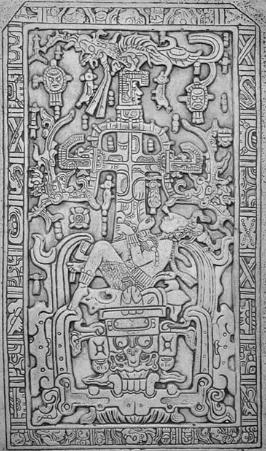
Remaining in Ecuador for one more example, on the left
is the lid of the famous Mayan ruler, Pacal. It was found in his burial
pyramid in the ancient city of Palenque and the king's body was discovered
beneath, thus suggesting that the figure in the carving is Pacal himself.
Mayan myth explains the depiction as the king falling
into the night time Underworld, only to be risen again during the day. The
Tree of Life above his head emphasises the king's journey after death.
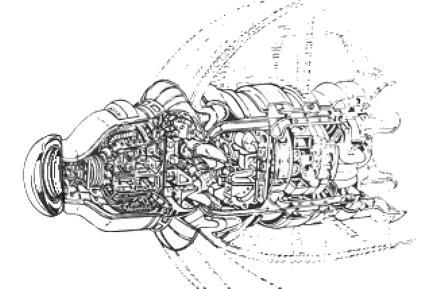 Despite
this description from actual Mayan texts, many researchers have claimed
that the sarcophagus lid shows a figure sitting inside some form of
airplane or spacecraft. There have even been attempts to recreate the lid
utilising technical methodologies, as shown on the right. Despite
this description from actual Mayan texts, many researchers have claimed
that the sarcophagus lid shows a figure sitting inside some form of
airplane or spacecraft. There have even been attempts to recreate the lid
utilising technical methodologies, as shown on the right.
A man in a piece of technology, his hands working
controls, breathing apparatus enabling him to breathe? Or is it as the
Maya themselves say, a representation of the dead king's journey into the
afterlife? Surely the Maya know best. After all, they were there!
South America is filled with oddities: the Nazca Lines
in Peru, the great Olmec stone heads of Mexico, the enigmatic city of
Tiahuanaco, high up on the Bolivian Altiplano. We find great cities built
from massive blocks of stone weighing hundreds of tons, seemingly
abandoned in an instant and swallowed by the jungle or left to decay in
the mighty Andes. But it is some of the smallest artefacts that furrow
brows the most.
 The
golden aircraft of ancient Colombia (left) are amongst the
most famous and mysterious of the Pre-Columbian Americas. The
golden aircraft of ancient Colombia (left) are amongst the
most famous and mysterious of the Pre-Columbian Americas.
Explained away as
depictions of animals such as birds, fish and bats, the trinkets bear
striking resemblances to modern, delta-winged aeroplanes. There have even
been claims by some researchers that aeronautical tests have proved that
they are perfectly shaped for flight.
Trinkets of
animals or scale models of aircraft? We may never know.
On the subject of
ancient aircraft, we must not forget to mention the vimaanas of the
mighty Sanskrit legend, the Mahabharata. These were described as fearsome
flying machines, possessing devastating weapons, that were used by the
gods in a great war against their enemies.
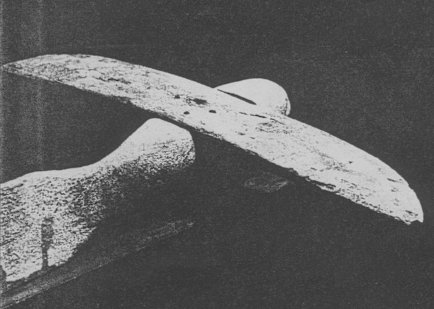 There
is also the famous 'Saqqara Bird' (right) that has been described
as being a model of a glider from Ancient Egypt. There
is also the famous 'Saqqara Bird' (right) that has been described
as being a model of a glider from Ancient Egypt.
It seems, however,
that the truth is far more down to Earth. Egyptian boats often had
mastheads that were topped with what were probably weather vanes in the
shapes of birds. These would tell the crew which way the wind was blowing.
So that's one mystery solved at least!
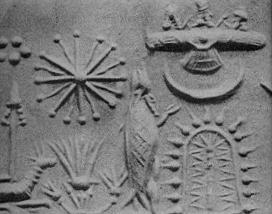 Over
in Mesopotamia, the Sumerian civilisation arose in the regions between the
rivers Euphrates and Tigris. Great cities such as Nippur, Uruk and Babylon
thrived at a time when much of the rest of the world lived in Stone Age
ignorance. They produced the first writings, the first mathematics, the
wheel and the first laws. Over
in Mesopotamia, the Sumerian civilisation arose in the regions between the
rivers Euphrates and Tigris. Great cities such as Nippur, Uruk and Babylon
thrived at a time when much of the rest of the world lived in Stone Age
ignorance. They produced the first writings, the first mathematics, the
wheel and the first laws.
Their legends told
us that fish-like beings known as the Annunaki came to Earth and taught
them everything they know. The cylinder seal on the right shows 'The Tree
of Life' beneath a flying vessel above a crescent moon. Many have wondered
why the Sumerians would show a tree in this way. It looks less like a
large plant and more like a DNA molecule (the real tree of life).
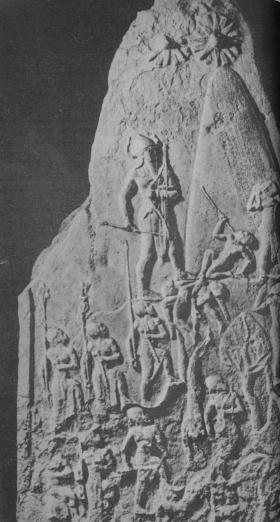 The
Victory Stele of Naram-Sin dates from 23rd-century BC Akkadia. The king is
celebrating a victory over his enemies by paying homage to 'the solar
disc'. A quick look at the stele, though, shows two solar emblems (at
least three, actually if you look closely at the very top, damaged
section). Since we have only ever had one sun, what do these other symbols
represent? The
Victory Stele of Naram-Sin dates from 23rd-century BC Akkadia. The king is
celebrating a victory over his enemies by paying homage to 'the solar
disc'. A quick look at the stele, though, shows two solar emblems (at
least three, actually if you look closely at the very top, damaged
section). Since we have only ever had one sun, what do these other symbols
represent?
An astronomical
event such as a supernova or planetary conjunction? A comet passing
by (Comet Hale-Bopp has been suggested)? Or even extra-terrestrial
spacecraft hovering above the victorious king.
This would not be
the first time that aerial phenomena have come to the aid of the warring
dictators of millennia past. The Bible is filled with examples of
Jehovah's angels coming to the assistance of the Hebrews in their battles
with their enemies. Alexander the Great was helped by flying 'burning
discs' as he laid siege to the city of Tyre and later, his army was
dive-bombed by silver discs. If Naram-Sin did receive air support from
above the clouds, then it suggests that aliens may have been tinkering
with our history throughout the ages.
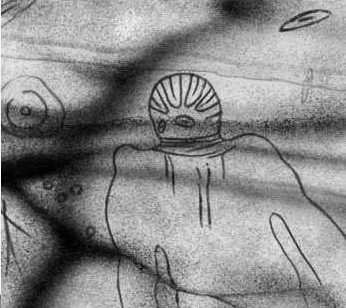 In
the Tassili Mountains of the Sahara Desert, artwork was painted and carved
into rocks at least 6000 years ago. Some of these depictions show very
curious features that cannot be easily explained. Flying discs, strange
animal forms and humanoid figures with bizarre features (such as 'The
Great Martian God', left) have been explained away as drug-induced
hallucinations or the products of the vivid imaginings of our ancestors. In
the Tassili Mountains of the Sahara Desert, artwork was painted and carved
into rocks at least 6000 years ago. Some of these depictions show very
curious features that cannot be easily explained. Flying discs, strange
animal forms and humanoid figures with bizarre features (such as 'The
Great Martian God', left) have been explained away as drug-induced
hallucinations or the products of the vivid imaginings of our ancestors.
Yet, amongst these
strange forms are accurately-drawn renderings of the animals of the
region, such as gazelles, so why include such abstract features? Perhaps
the strange humanoid figures are depictions of native people wearing
ceremonial headgear? How does this explain the flying discs? Our ancestors
were excellent illustrators of nature. They drew what they saw. Is it
possible that they saw alien life-forms come to earth and they simply
recorded it for posterity?
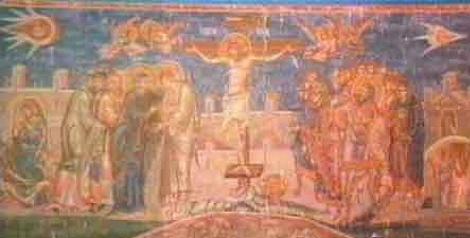 In
the former Yugoslavia, the Visoki Decani Monastery has many, many
beautiful frescoes of religious scenes. The one on the right is called
'The Crucifixion' and dates from AD 1350. In
the former Yugoslavia, the Visoki Decani Monastery has many, many
beautiful frescoes of religious scenes. The one on the right is called
'The Crucifixion' and dates from AD 1350.
To the left and
right of the Cross there are two flying objects that are piloted by what
seem to be humans. The vessel on the right emphasises its mechanical
nature by having an insignia painted on its side! One seems to be pursuing
the other and the chap on the right seems distressed that he is being
chased by the serious-looking fellow on the left.
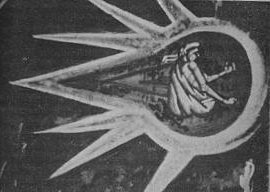
 Why
is this peculiar interaction taking place in a scene of Our Lord's sombre
passing? Is it symbolic? Of what? Was the artist using his imagination and
if so, what is he trying to say and why? Why
is this peculiar interaction taking place in a scene of Our Lord's sombre
passing? Is it symbolic? Of what? Was the artist using his imagination and
if so, what is he trying to say and why?
Is the painting a
realisation of something was actually scene by the artist, or described to
him by a witness? It is a bizarre piece of art. Beautiful and compelling,
yet perplexing.
We have seen
artworks from thousands of years ago right up to only a few hundred years
ago. There are myriad other examples, but I have concentrated on only a
few. Were Von Daniken and his counterparts correct? Have
extra-terrestrials landed on our world and affected our history or are all
the strange and mysterious representations we have seen nothing more than
imaginative renderings by talented artists?
I know what I
think, but I'll leave you to draw your own conclusions...
© 2005 Steve Johnson |